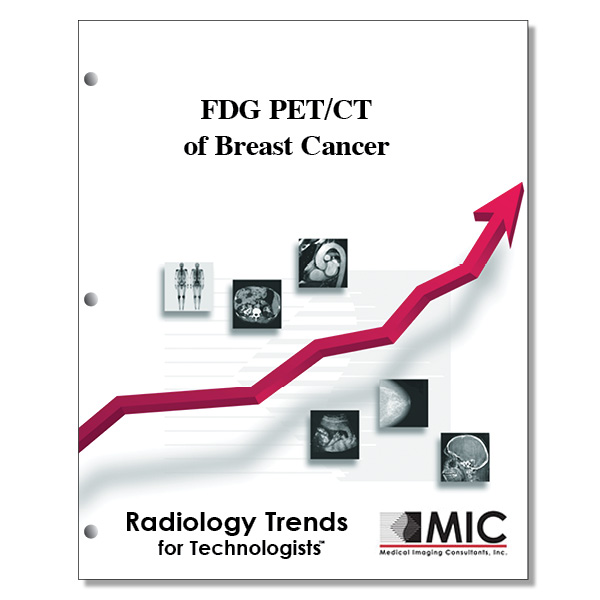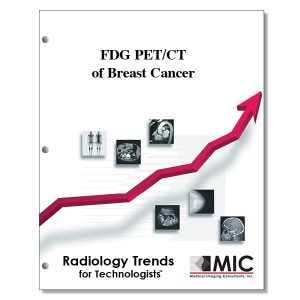

FDG PET/CT of Breast Cancer
The role of FDG PET/CT is investigated for diagnosis, initial staging, follow-up, and evaluation of response to therapy in breast cancer.
Course ID: Q00375 Category: Radiology Trends for Technologists Modalities: CT, Mammography, Nuclear Medicine, PET, Radiation Therapy3.5 |
Satisfaction Guarantee |
$37.00
- Targeted CE
- Outline
- Objectives
Targeted CE per ARRT’s Discipline, Category, and Subcategory classification:
[Note: Discipline-specific Targeted CE credits may be less than the total Category A credits approved for this course.]
Breast Sonography: 2.25
Patient Care: 2.25
Patient Interactions and Management: 2.25
Mammography: 2.25
Patient Care: 1.00
Patient Interactions and Management: 1.00
Procedures: 1.25
Mammographic Positioning, Special Needs, and Imaging Procedures: 1.25
Nuclear Medicine Technology: 3.50
Procedures: 3.50
Endocrine and Oncology Procedures: 3.50
Registered Radiologist Assistant: 3.50
Procedures: 3.50
Thoracic Section: 3.50
Radiation Therapy: 3.50
Patient Care: 1.75
Patient and Medical Record Management: 1.75
Procedures: 1.75
Treatment Sites and Tumors: 1.75
Outline
- Introduction
- Principles of PET/CT
- FDG Uptake of Breast Cancer Depends on the Histologic and Biologic Characteristics of the Tumor
- FDG PET/CT Has Little Role in Differentiating Benign from Malignant Breast Lesions
- Role of FDG PET/CT in Assessment of Multifocality and T Category of Breast Cancer
- FDG PET/CT Comparison with Sentinel Node Biopsy for Axillary Staging
- Regional and Distant Staging in Large, Locally Advanced and Inflammatory Breast Cancer (Stages II-III
- Detection of Lymph Node Involvement Outside Berg I and Berg II Levels
- Detection of Distant Metastases
- In Which Patient Should FDG PET/CT Be Performed at Initial Staging
- Performance of PET/CT in Restaging of Breast Carcinoma
- Performance of PET/CT for Treatment Response Assessment
- Early Evaluation of Neoadjuvant Chemotherapy with PET with or without CT
- Evaluation of Response of Metastatic Disease with FDG PET/CT
- Assessment of Response to Hormonal Therapy: The Paradoxical Metabolic Flare
- Prognostic Value of FDG PET (/CT
- Conclusion
Objectives
Upon completion of this course, students will:
- be familiar with the advantages of combined PET/CT imaging
- know the currently recommended whole-body imaging modality used for restaging in breast cancer patients with known or suspected recurrence
- understand the information which CT imaging adds to the PET information in combined PET/CT imaging
- be familiar with the typical scanning procedure for FDG whole body PET/CT imaging for oncology
- understand how FDG is metabolized within cells
- know the factors which affect tumor detection in PET imaging
- understand the methods of standardized uptake value (SUV) calculation
- know the most important factor to standardize for an FDG oncology imaging procedure within an institution
- understand the risk posed in response evaluation due to the partial volume effect in PET imaging
- identify the factors which correlate with FDG uptake intensity in breast cancer
- know the term describing the measurement of cell division within a tumor
- understand what high levels of Ki-67 typically indicate
- understand the term triple-negative for breast tumors
- identify the function of the p53 gene
- know the basis for tumor grading
- understand the differences in the classification methods of tumors
- be familiar with the Nottingham grading system for breast cancer
- identify a procedure cited by some authors for improving specificity of FDG PET imaging for breast cancer
- understand the role of FDG PET in the assessment of multi-focal breast cancer primary lesions
- know the gold standard method for axillary staging of breast cancer
- identify the three methods included in a triple-assessment for breast cancer prior to an axillary clearance procedure
- be familiar with findings that demonstrate a very high yield of FDG PET uptake
- understand the TNM Stage Grouping for breast cancer according to the AJCC Cancer Staging Manual
- be familiar with the Berg categorization method of axillary lymph node classification
- know the relationship between breast cancer axillary lymph node involvement and the utilization of axillary clearance
- know what clinical findings constitute an N3 (stage IIIC) lesion
- be familiar with the results of studies evaluating FDG PET/CT for staging
- know the types of bone lesions which display with FDG PET imaging
- know when FDG PET/CT imaging is appropriate for initial staging of breast cancer
- be familiar with the studies which evaluated FDG PET/CT for breast cancer restaging
- understand the strengths of PET/CT for breast cancer restaging
- know the usefulness of PET/CT when a breast cancer recurrence is depicted or suspected
- be familiar with the two meta-analyses encompassing PET/CT imaging for breast cancer restaging
- be familiar with adjuvant and neoadjuvant therapies and understand the differences in when they are given
- be familiar with the factors used by physicians in order to recommend adjuvant therapy for those patients who are at higher risk for recurrence
- know the factors listed in the article for SUV cutoff value variance for treatment response assessment
- understand the examination of early FDG PET monitoring of breast cancer and the criteria used to assess breast cancer therapy effectiveness
- know the deficiencies of CT in response assessment imaging
- be familiar with the European Organization for Research and Treatment of Cancer’s criteria for partial metabolic response and progressive disease
- understand the FDG uptake response to hormonal therapy
